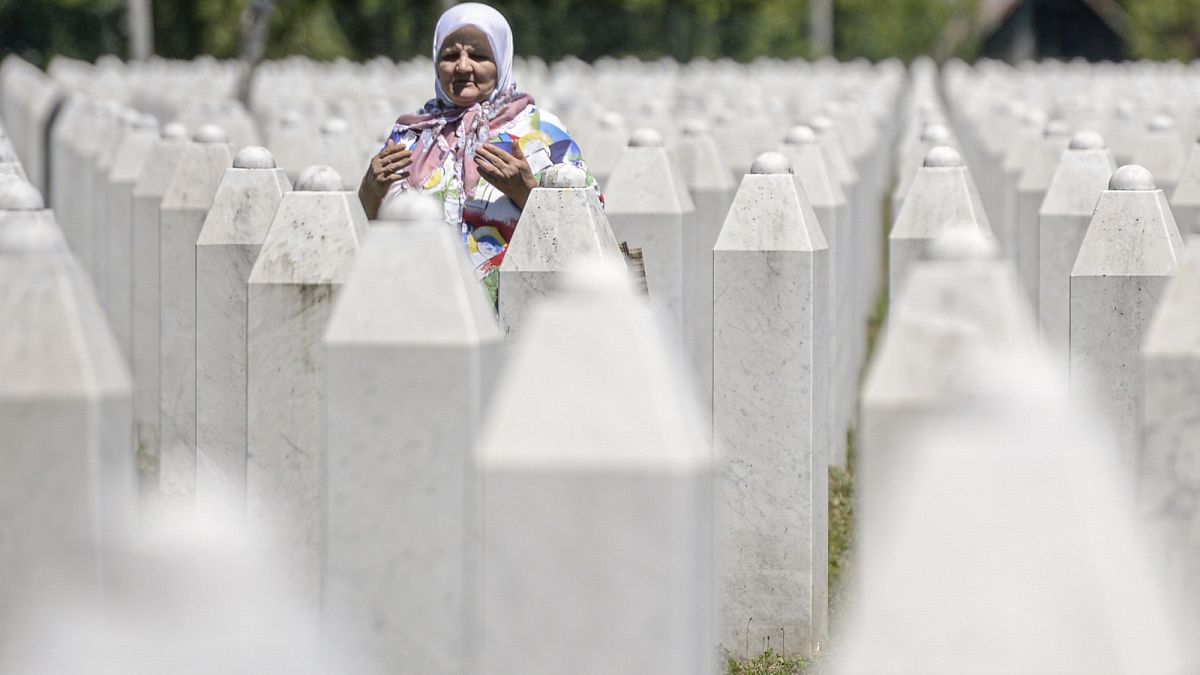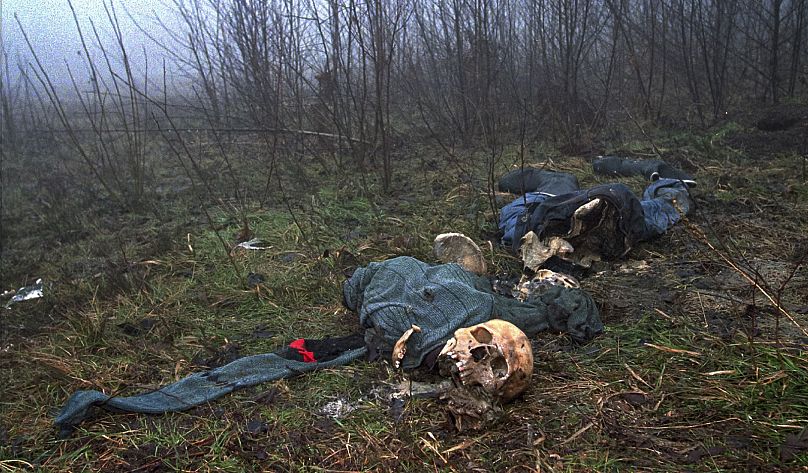As the world begins to grapple with the legacy of its darkest episodes, the way in which the history of what happened in Bosnia and Herzegovina over 20 years ago is told is should now be challenged before it poisons another generation.
In the hills above Sarajevo, in the small town of Pale, there is a university dormitory named after Radovan Karadžić, the Bosnian Serb wartime leader who was sentenced to life in prison for the crime of genocide in 2016.
During the Bosnian war from 1992 to 1995, both the Bosnian Serb military and political leadership were headquartered in Pale, and it was in this relatively obscure town overlooking the Bosnian capital where they planned and ordered a genocide. To honour Karadžić by putting his name on a student dormitory is to revere a man driven to war crimes by ethno-nationalism. It is but one example among many of how genocide denial has become mainstream thanks to Bosnian Serb leaders in the Serb-dominated entity of Republika Srpska, where this denial is deep and pervasive.
Indeed, to what lengths will Bosnian Serb authorities go to implicate Serb youth in crimes committed before they were even born? Most, if not all, of the students who reside in the dormitory named for Karadžić are surely Serb, as Republika Srpska was largely “cleansed” of non-Serbs during the war. It is still rare for non-Serb students to study at Serb majority universities. Moreover, I find it impossible to imagine that any Bosniak or Croat student could step foot in a dormitory named for a genocidaire like Karadžić, just as I cannot imagine a Jewish student living in a dormitory named for Hitler.
But, for Serb students, this should not be normalised either. As a wave of reckoning washes over the world, as statues come down and buildings are renamed to right the many wrongs in how our histories have been told, in Bosnia and Herzegovina, we must reckon with how the history of what happened just over two decades ago is being told.
The genocide carried out in Bosnia and Herzegovina was a project of neighbouring Serbia, achieved through Bosnian Serb political and military proxies. But genocide requires the psychological preparation of a population through propaganda that dehumanises an “other” and frames them as a “threat” and the “enemy,”, to facilitate their recruitment into military actions that result in genocide or their complicity through silent acceptance. In the case of Bosnia and Herzegovina, it was primarily Bosnian Muslims (Bosniaks) who were identified as the “other” and it was ethno-nationalism that functioned as the driving force behind actions by the Serbian state and Bosnian Serb proxies.
Nationalism defines who does and does not have the right to survival. It is for this reason that lawyer Raphael Lemkin argued that genocide entails much more than killing – it includes elements of social and cultural destruction, too. Echoing this, sociologist Martin Shaw has noted that “defining genocide by killing misses the social aims that lie behind it.” Yet, most governments do define genocide by killing, and by the numbers of people killed in single incidents.
And so, after over three and a half years of “ethnic cleansing” and some 100,000 people killed in Bosnia and Herzegovina, it was only after Serb forces overtook the UN safe area of Srebrenica and killed 8,000 Bosnian Muslim men and boys over several days that the international community was finally compelled to intervene.
This distinction, between the genocidal crimes committed in Srebrenica and those committed earlier in the war, was made by most governments at the time and has been made by many scholars since, raising questions about how these crimes are qualified. During my work as both a journalist and an academic researcher, I have maintained that the genocide carried out in Bosnia and Herzegovina should be viewed as a process that began in 1992, followed a pattern, and culminated with mass violence in Srebrenica. In part, this is due to my belief that genocide is distinguished by how the enemy is understood. Is it the State or a social collective? As Shaw has explained, “genocidal practices... treat social groups as enemies.”
The archives of the war crimes tribunal for the former Yugoslavia remain unexplored by most academic researchers interested in the Western Balkans, but they offer important insights into the criminal minds of individuals who committed genocide and other war crimes in Bosnia and Herzegovina. And it is clear that for many Serbs tried by the tribunal, Muslims as a group were viewed as the enemy and as the target of genocide.
Transcripts from the parliament of the wartime Bosnian Serb Republic are available, for example, and include discussions by Serb members of the intent and consequences of genocide. In one session, a member was applauded by his fellows when he boasted that the city of Prijedor was no longer a “green” municipality - meaning that it no longer had a Muslim majority. “We fixed them and sent them packing where they belong,” he said. In August 2013, it became clear where these Muslims had been “sent packing” when the largest mass grave to date was discovered in Bosnia and Herzegovina in the village of Tomašica, 17 km south of Prijedor.
Among those who very likely applauded the fact that Prijedor was no longer “green” was Milorad Dodik, then a member of the wartime Bosnian Serb parliament and now a member of the tripartite Bosnian Presidency. While Dodik seemed to retreat from ethno-nationalism in the immediate post-war period, even appearing to be an ally of the West in rebuilding the Bosnian state and working to restore inter-ethnic relations, he has since recommitted to his ethno-nationalistic roots by actively engaging in genocide denial.
It was Dodik who opened the dormitory named after Karadžić in 2016, and Dodik who continues to foster a relationship with Serb youth in Republika Srpska which can only be compared to that of a captor and his hostages, locked in a sort of Stockholm syndrome that keeps young people in the entity captive to an ethno-nationalistic discourse they feel powerless to escape.
Dodik has the open support of Serbian president, Aleksandar Vučić, and heeds the cues of Serbian leadership more broadly which has led the campaign of Bosnian genocide denial just as it orchestrated the genocide itself under the leadership of Slobodan Milošević. Perhaps it is unsurprising then that Dodik has good relations with leaders like Putin and Orban. But it is problematic that he is treated as a legitimate partner by many European diplomats as well.
After all, in international diplomacy, what is the obligation of a bystander to genocide denial? What is the responsibility of an international actor who fails to intervene? If the EU is in a position to influence officials in Republika Srpska by threatening to end talks until they remove the name of Karadžić from the dormitory in Pale, shouldn’t they use this leverage? And if they don’t, aren’t European leaders complicit now as they were when they looked the other way from “ethnic cleansing” during the war?
The EU must recognise that opportunities to pressure Bosnian Serb and Serbian leaders to treat history objectively should not be wasted. These are not just lost chances to influence educational curricula or encourage inter-ethnic reconciliation; they are openings to pushback against narratives of denial that have become so typical in Bosnia and Herzegovina, especially in the Republika Srpska, that many Serbs are proud to see Karadžić’s name publicly celebrated as a “founder of the Republic.”
This kind of revisionism transforms war criminals into heroes and makes victims out of aggressors, and if it is not called out by those willing to speak truth to power, it will poison future generations and challenge the prospect of long-term peace in Bosnia and Herzegovina.
- Edina Bećirević is Professor of Security Studies at the University of Sarajevo and author of 'Genocide on the Drina River'
_____________
Are you a recognised expert in your field? At Euronews, we believe all views matter. Contact us at view@euronews.com to send pitches or submissions and be part of the conversation.

